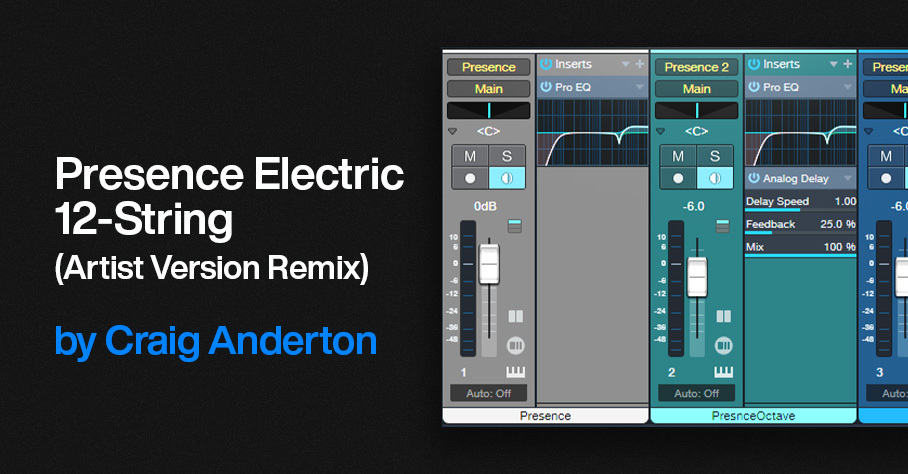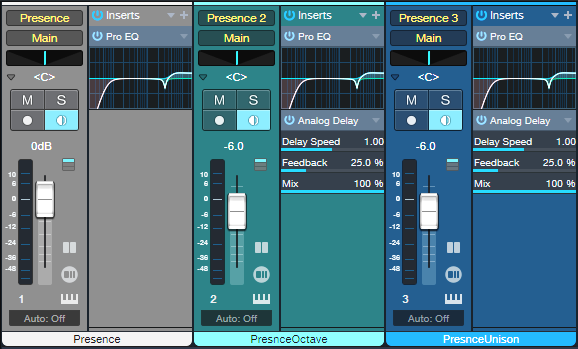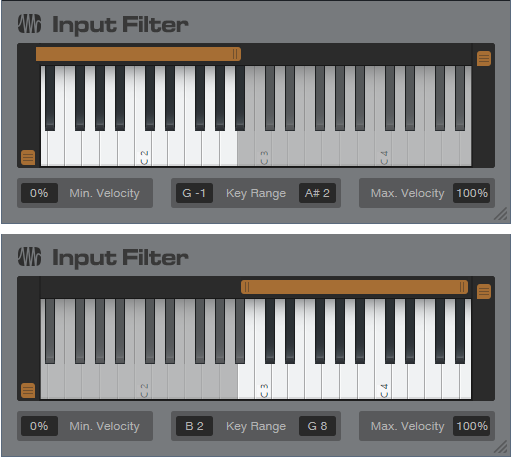Presence Electric 12-String (the Artist Version Remix)

Presence’s sound library includes a fine acoustic 12-string guitar, but not an electric one. So, perhaps it’s not surprising that one of the more popular blog posts in this series was about how to create a realistic electric 12-string preset with Presence.
Unfortunately, that was before Studio One introduced Track Presets. The preset relied on a Multi Instrument, so it worked only with Studio One Professional. However, thanks to Track Presets, we can revisit our electric 12-string, and make a plug ’n’ play version that works for Studio One Artist as well as Professional (download link at the end).
Overcoming the Sampling Problem with 12 String Guitars
Sampling a 12-string is difficult. The sound is constantly changing due to the shimmering effect from slightly detuned strings. Furthermore, some notes are doubled with octave-higher notes, while other notes are doubled with unison notes. My solution is not to try and sample a 12-string guitar, but to construct one from three sets of 6-string guitar samples.
Each of the three Presence instances (fig. 1) loads the preset Guitar > Telecaster > Telecaster Open from the stock Presence library:
- One instance provides the main guitar sound.
- Transposing another instance up 12 semitones provides the octave-above notes.
- A physical 12-string guitar doesn’t have octaves on the 1st and 2nd strings, so the third Presence instance provides a unison sound for the higher strings.
Figure 1: With three instances needed to create a single instrument, note that all three Monitor buttons must be enabled to play the instrument from your keyboard or MIDI guitar controller.
Limiting Note Ranges
In the original preset, Multi Instrument Range edits prevented the unison sounds from overlapping with the octave-above sounds. In the Artist preset, two Input Filter Note FX restrict the ranges (fig. 2).
Figure 2: The upper Note FX Input Filter restricts the range of the octave-above notes to A#2 and below. The lower Note FX Input Filter restricts the range of the unison strings to B2 and above.
Emulating the 12-String “Shimmer”
A 12-string is never perfectly in tune, which gives a shimmering effect. The octave instance is transposed up +12 semitones, but the Pitch Fine Tune setting is +5 cents. The unison instance Pitch Fine Tune is -2 cents. This gives the chorus-like that’s inherent in 12-string guitars. Detuning the virtual strings provides a more realistic sound than trying to “fake it” with a time-based modulation effect.
About the Analog Delays
The higher string in a pair of strings plays just a little bit late, because your pick hits the main string before the octave or unison string. To emulate this effect, the Analog Delay (fig. 3) provides a 20 ms delay for the octave and unison instances. (We can’t use Presence’s Delay, because the mix needs to be 100% delay—no dry sound.)
Figure 3: Analog Delay settings used to emulate string pluck delay.
Without this delay, the emulated 12-string lacks realism. The Analog Delay also adds some High Cut to reduce some of the brightness caused by transposing the octave strings. The Width settings provide a big stereo image, but for a more “normal” sound, turn ping-pong mode to Off.
The octave and unison instance levels are -6 dB below the main guitar sound. With physical 12-string guitars, the octave strings are thinner than the strings that generate the standard pitch. So, they generate less output. Lowering the level of the octave strings gives a better overall balance. Technically, the unison strings could be at the same level, but their levels are also a little lower to avoid an unbalanced sound compared to the octave strings.
EQ Settings
The Octave and Unison string instances use Presence’s internal EQ to attenuate the highest and lowest frequency bands. The main instance attenuates the low band, but peaks +3 dB at 3 kHz. Regarding the Pro EQ3 settings, open up the preset if you want to deconstruct the programming. The main aspects are a bass cut to give a more trebly, “Ricky”-like 12-string sound, a high-shelf boost for a little extra brightness, and a narrow notch around 3.2 kHz to reduce some “string ping” inherent in the original samples. As always, though, adjust for your tastes in guitar tone.
So, Studio One Artist aficionados, what are you waiting for? Download the preset, and get ready to make some cool electric 12-string sounds.
Download CA 12-String Electric Artist.trackpreset here!


